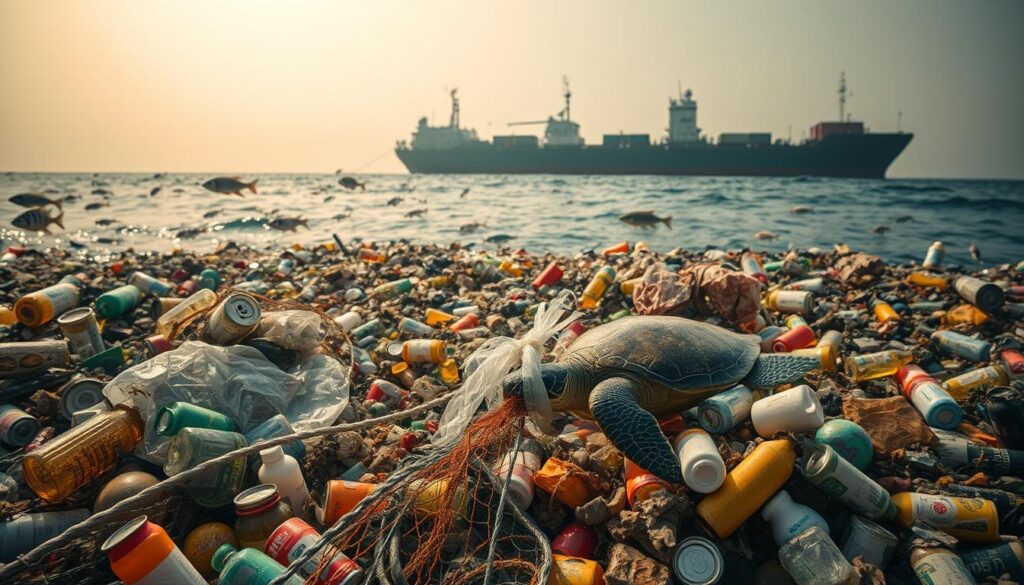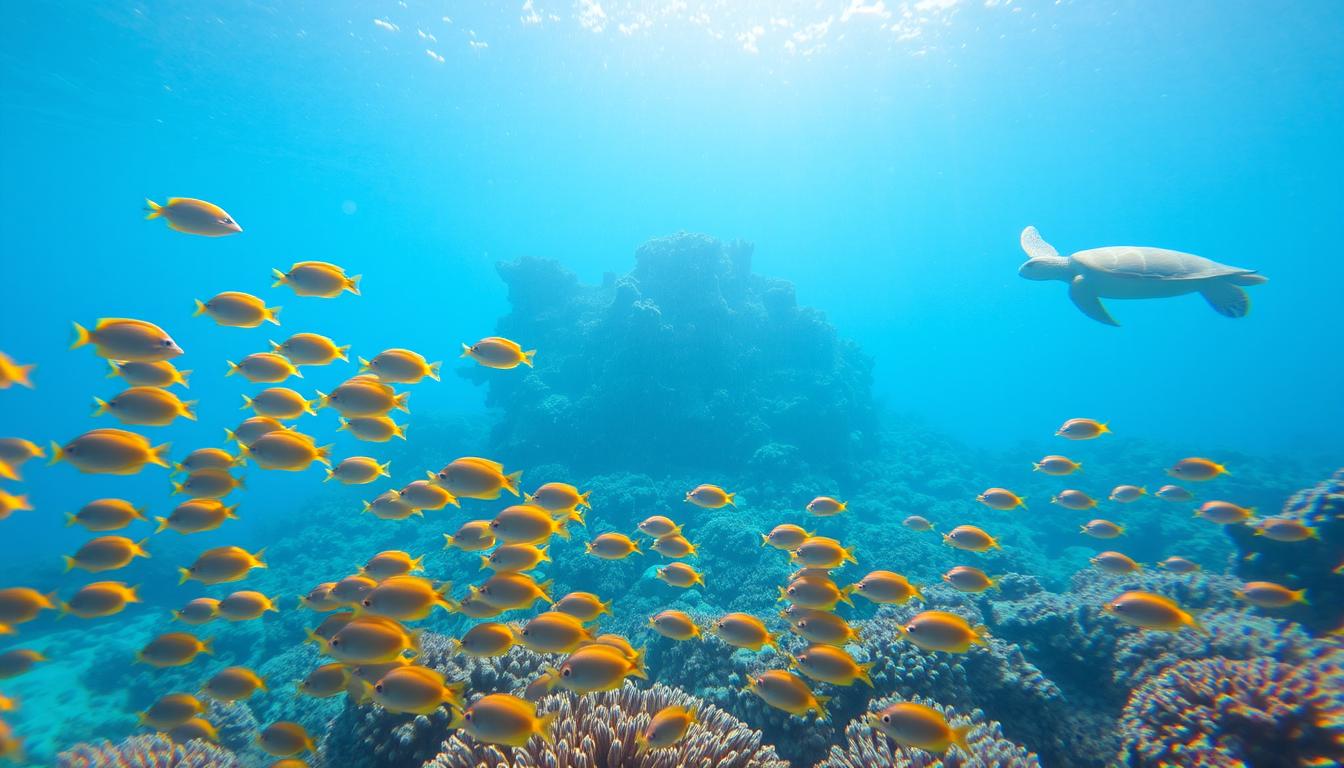The ocean is big, covering 71% of our planet. It is home to many creatures, big and small. From the tiny plankton to the huge whales, each life form is special. These underwater worlds are very important. They help keep our planet’s environment balanced. They add a lot to the ocean’s rich variety of life.
Key Takeaways
- The ocean covers 71% of Earth’s surface, hosting diverse marine life.
- Marine ecosystems maintain the environmental balance.
- From plankton to whales, each species plays a vital role.
- Oceans are key to Earth’s biodiversity.
- Conservation efforts are vital to protect marine habitats.
Introduction to Marine Life
The marine ecosystem is full of different life forms. It’s very important for our planet’s environment. Oceans cover more than 90% of where life exists on Earth. They are home to many sea animals and tiny living things. This environment makes a lot of the world’s oxygen. It also helps absorb carbon from the air.
The Importance of Marine Life
Marine life keeps the ocean healthy and balanced. The ocean is a big source of food and supports many jobs. It’s key in the world’s nutrient cycles. Tiny organisms and big sea animals are all important. They help each other survive. Without them, the whole marine ecosystem would suffer. This would impact everything from tiny plankton to big whales.
The Ocean’s Biodiversity
There are so many different kinds of life in the ocean. Over 242,000 marine species are known. But there might be two million more we don’t know about. Each year, scientists find about 2,332 new species. This shows the ocean is always changing. Most of the living mass in the ocean is tiny organisms. These tiny life forms live in extreme places, like very deep trenches.
If you want to know more about all the different marine life, check out more information here.
Coral Reefs: The Rainforests of the Sea
Coral reefs are like the rainforests of the sea. They are very important and full of life. These places are home to lots of water animals and help people too.
Ecosystem Services Provided by Coral Reefs
*coral reefs* do a big job by helping many water creatures live and grow. They are places where fish and other sea life start their lives. Coral reefs also protect coasts from getting washed away by stopping erosion and big waves. This keeps people living near the shore safe.
The Diversity within Coral Reefs
*coral reefs* are amazing because they have so many different kinds of life. Thousands of fish, crabs, and other sea creatures live there. All these animals work together to keep the ocean healthy. This shows how *coral reefs* are super important for life under the sea.
The Mysteries of Deep-Sea Creatures
Deep under the ocean, far from sunlight, there is a world full of unique life. This place, known as the abyss, has some of the coolest deep-sea creatures in marine biology.
Adaptations for Deep-Sea Survival
Living deep in the sea is tough. Creatures there face huge pressure, cold, and darkness. A cool trick they have is bioluminescence. It means they can glow. Creatures like the anglerfish glow to catch food or talk to each other.
Fascinating Deep-Sea Species
Some deep-sea creatures are amazing. Like the giant squid, which gets really big. And the weird gulper eel with its big mouth. The deep sea is full of interesting life. It shows how much we still have to learn about the ocean.
Marine Life and Climate Change
Climate change deeply affects marine life and ocean ecosystems. It causes sea temperatures to rise and oceans to become more acidic. This is a big problem for marine animals and plants.
Impact on Coral Reefs
The biggest impact can be seen in coral bleaching. This happens when the water gets too warm. Corals lose their color and the life that depends on them is harmed.
Shifting Marine Species Distributions
Animals in the ocean are moving to colder waters because of climate change. This changes their homes and can harm local animal numbers. It messes with who eats who, where animals have babies, and the sea’s natural balance.
The way climate change and marine life interact is complicated. We need to understand and fight these changes. It’s important for keeping the ocean healthy for all living things, including us.
Ocean Ecosystems: From Mangroves to Seagrass Meadows
Ocean ecosystems like mangroves and seagrass meadows are key for marine conservation and global biodiversity. They offer many ecological benefits. This includes great carbon storage and being nurseries for young sea animals.
Mangroves are found in warm places. They keep coastlines safe from erosion and storms. They also offer homes and places to breed for fish, birds, and crustaceans.
Seagrass meadows are just as important for the ocean. They hold sediment in place, make water clear, and store lots of carbon. These underwater fields are full of life, like sea turtles, dugongs, and many fish.
| Ecosystem | Main Benefits | Main Inhabitants |
|---|---|---|
| Mangroves | Coastal protection, nursery habitats, carbon sequestration | Fish, crustaceans, birds |
| Seagrass Meadows | Sediment stabilization, water clarity enhancement, carbon storage | Sea turtles, dugongs, various fish species |
It’s crucial to understand and save these places for healthy and strong oceans. We need to protect mangroves and seagrass meadows. This will help keep our sea life diverse and thriving.
Marine Life Conservation Efforts
Marine conservation helps keep oceans healthy and full of life. It includes creating safe areas for sea creatures and working with communities. These actions aim to protect ocean animals and their homes.
Marine Protected Areas (MPAs)
MPAs are special places in the ocean where activities are limited to protect marine life. They help preserve important habitats, support many species, and let ocean life flourish. About 7.7% of the oceans are in MPAs. Examples include Australia’s Great Barrier Reef Marine Park and the Papahānaumokuākea Marine National Monument in the U.S. These areas help protect endangered animals and are important for science.
Community-Based Conservation Strategies
Community-based strategies involve local people in protecting the ocean. Including communities in conservation leads to better results. These methods support the well-being of local fishermen and the health of the oceans. In Fiji, local marine areas (LMMAs) show how this balance can work. Efforts by communities show that using local knowledge and teamwork can greatly help in saving ocean life and habitats.
The Role of Marine Life in Human Culture and Economy
Marine life has a big effect on human culture and the world’s ocean economy. It supports thousands of communities everywhere.
Fisheries and Food Security
Fisheries help keep food on the table. They provide important protein for billions of people. We need to fish smart to protect our oceans and help people who rely on them. It’s tough but important to keep oceans healthy while making a living from them.
Ecotourism and Recreational Activities
Ecotourism lets millions see marine life up close. This love for nature helps the ocean economy grow. It also encourages protecting sea life. Fun activities like diving and tours create jobs and help towns.
Marine life, fisheries, and ecotourism all show how the ocean is key to our economy and health. We must work together for a future where both people and the ocean can thrive.
Technological Advances in Marine Biology Research
Recent technological advances have changed marine biology a lot. Now, researchers can look into parts of the ocean never seen before. These new tools give us more info about underwater life. They show us new creatures and places under the sea.
Use of Remote Sensing and Drones
Remote sensing and drones have changed marine studies. Technological advances in satellites and drones help map the ocean better. They track where sea animals go and check if ocean homes like coral reefs are healthy.
Discoveries from Deep-Sea Exploration
Exploring the deep sea has always been hard. But now, with special subs and robots, it’s possible to study deep waters. These technological advances let scientists gather info from the deep sea. They find new sea life and places, helping us understand deep-sea life better.
In conclusion, new deep-sea tech has grown our knowledge of the ocean. It helps us learn and protect the ocean’s secrets.
Challenges Facing Marine Life
Our oceans are home to many forms of life. But, they are in danger because of people. Pollution, too much fishing, and destroying homes are big problems. These problems hurt the homes of sea creatures and all that live there.
Plastic Pollution
Plastic in the ocean is a huge problem everywhere. Every year, tons of plastic end up in the sea. This is bad for creatures like turtles, birds, and fish. They eat the plastic by accident, which can hurt or even kill them. This problem messes up the food chain in the ocean.

Overfishing and Habitat Destruction
Fishing too much causes fish numbers to drop quickly. This makes it hard for fish populations to recover. It’s bad for all creatures in the sea, not just fish. Losing their homes makes things worse. Important places like coral reefs and mangroves get destroyed.
These places are needed for fish and other sea life to eat, hide, and have babies. The combination of too much fishing and destroying homes makes life hard for sea creatures. We must use the ocean in a smart way and work together worldwide. This will help keep the ocean healthy and full of life for everyone in the future.
Conclusion
Exploring marine life shows us how important our oceans are. From the colorful coral reefs to deep-sea creatures, the ocean is full of life. These places are home to many species and help people too, like giving us food.
We face big problems like plastic in the sea and too much fishing. We need to work hard to save our oceans. Using new science and careful planning can help us protect the oceans.
The ocean’s health depends on what we do and working together worldwide. If we all help and use smart ways to live, we can keep the ocean safe. Our oceans matter to everyone, everywhere.
